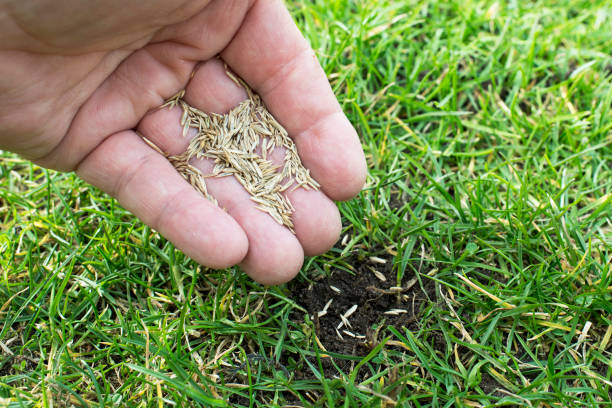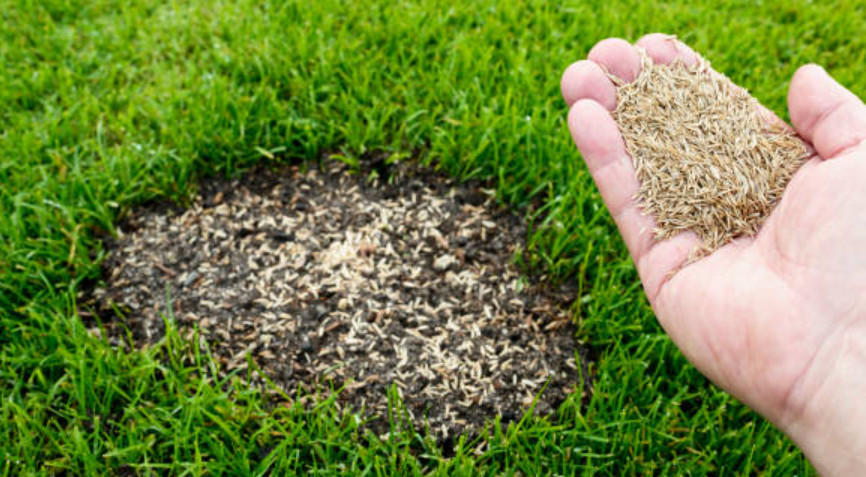Embarking on the journey to cultivate a lush, verdant lawn is an endeavor filled with anticipation and curiosity. Central to this quest is the pivotal process of grass seed germination—a stage that marries the art of patience with the science of botany. In our comprehensive guide, “How Long Grass Seeds Germinate,” we delve deep into the heart of this crucial phase, unraveling the mysteries that dictate the awakening of life from within these tiny capsules of potential.
Our expertise in horticulture and passion for green spaces empower us to provide you with insights grounded in scientific research and practical wisdom. We understand that the germination of grass seeds is not merely a waiting game; it’s a nuanced dance with nature, influenced by variables such as seed type, soil conditions, moisture levels, and temperature. By exploring these factors, we equip you with the knowledge to set the stage for successful germination, ensuring that your efforts result in a lawn that not only thrives but flourishes.
Whether you’re a seasoned gardener or a green-thumbed novice, the value of understanding the germination process cannot be overstated. It’s the foundation upon which the beauty and health of your lawn are built. With our guide, we aim to ignite your curiosity and encourage you to engage deeply with the process, transforming what might seem like a mundane wait into an exciting period of growth and discovery.
Join us as we embark on this verdant voyage, where each day brings you closer to the dream of stepping out into a sea of green, nurtured by your own hands. Let “How Long Grass Seeds Germinate” be your compass in the garden, guiding you through the intricacies of germination and beyond, towards a lush, thriving lawn that stands as a testament to your dedication and love for nature.
Getting Started
Understanding Grass Seed Labels

When you pick up a bag of grass seed, you’ll notice there is a lot of information printed on the label. This data provides insight into the seed quality. Here’s what to look for:
- Seed mix: The bag will list the grass species included in the mix. Cool-season grasses like perennial ryegrass and fescues are common.
- Purity percentage: This indicates the amount of desired grass seed versus other material. Look for a purity of 90% or higher.
- Germination rate: The expected percentage of seeds that will sprout. Aim for 85% or higher.
- Packaging dates: Check the “packed for” and “sell by” dates. Use fresh seed packed for the current year.
These metrics help you select viable, high-quality seed perfect for starting a new lawn.
Choosing the Best Grass Seed for Your Lawn
With so many grass seed varieties available, how do you choose what’s right for your lawn? Here are some top options:
- Perennial ryegrass germinates quickly and provides fine-bladed texture. It does require more maintenance.
- Tall fescue has good wear tolerance and shade adaptation. The bunch-forming growth habit leaves some bare spots.
- Fine fescue varieties resist heat and drought. Planting with other grasses provides the best coverage.
Consider factors like sun exposure, climate, and desired use to select the optimal seed mix for your needs. Your local garden center can provide tailored guidance.
Best Soil and Weather Conditions for Planting Grass Seed
Grass seed needs proper soil and weather conditions to thrive. Here’s what to aim for:
- Soil temperature: Cool-season grasses grow best when soil is 55-65°F. Use a thermometer to test before planting.
- Soil pH: Test and amend soil to reach a pH of 6.0-7.0. Acidic soil will hinder germination.
- Moisture: Seed needs consistent moisture to sprout and take root. Plant before rainy periods.
- Sunlight: At least 6 hours of direct sun per day provides the light needed for growth.
Paying attention to these environmental factors will set your new lawn up for success right from the start.
Preparation and Planting
Getting the site ready before sowing seed is an important first step. Follow these tips for ideal conditions.
Preparing Your Lawn for Seeding
Proper soil preparation sets the stage for your seed to flourish:
- Remove debris, stones, and weeds from the area.
- Loosen compacted soil and break up large clumps using a rototiller.
- Add a starter fertilizer or compost to provide nutrients.
- Level and rake the area to create an even surface for sowing.
Organic fertilizers release slowly over time, nourishing seedlings. Quick-release synthetic fertilizers can burn tender roots.
How Long Grass Seeds Germinate?
Grass seeds typically germinate within 5 to 30 days, depending on various factors such as the type of grass seed, weather conditions, soil moisture, and soil preparation. Factors like the type of grass seed, weather conditions, and soil pH can influence the germination time. For example, cool-season grasses like Kentucky Bluegrass can take 14-30 days to grow, while Ryegrass may sprout in 5-10 days. It is essential to keep the soil moist but not overly wet, sow the seed at the right time of year when soil temperatures are adequate (at least 8 degrees Celsius), and choose a high-quality seed mix for successful germination. Additionally, pre-germinating grass seeds by soaking them before planting can help accelerate the sprouting process.
Our Step-by-Step Video Guide on How to Sow Grass Seed
If you’re a visual learner, be sure to check out our step-by-step video detailing the seed sowing process. Here are some key takeaways:
- Divide seed into two batches and sow in perpendicular passes for even coverage.
- Use a drop or broadcast spreader for larger areas and a hand spreader for spots.
- Lightly rake seeded areas to bury seed and improve soil contact.
- Gently tamp the area with a lawn roller to further improve germination rates.
Following these sowing steps will help you achieve full, uniform lawn coverage.
Common Mistakes to Avoid When Sowing Grass Seed
While sowing grass seed may seem straightforward, it’s easy to make mistakes. Be sure to avoid these common errors:
- Broadcasting by hand leads to uneven coverage. Always use a spreader.
- Allowing seed to remain on the soil surface will lead to poor germination.
- Heavy raking can bury seed too deeply to sprout. Lightly work seed into soil instead.
- Sowing more thickly than recommended is wasteful and leads to crowded, clumpy growth.
With attention to detail during the sowing process, you can avoid these pitfalls for better results.
Aftercare and Growth
Once seeded, consistent care and monitoring are required to foster lawn growth. Be diligent with these aftercare steps.
Watering Techniques for Optimal Growth
Proper watering is crucial for seed germination and growth. Follow these tips:
- Water lightly and frequently, keeping top 1 inch of soil moist.
- Adjust duration based on weather, applying more water during hot, dry periods.
- Water early in the day to minimize evaporation loss.
- Reduce frequency as grass matures but give deep soakings to encourage deep roots.
Consistent moisture accelerates germination, supporting lawn establishment.
Aftercare: The Key to a Lush Lawn
In addition to watering, follow these aftercare steps:
- Apply starter fertilizer again when grass reaches 3 inches tall.
- Mow once the lawn reaches 3.5-4 inches for the first time. Set blades high.
- Reseed bare or thin areas to fill in for full coverage.
- Pull weeds when small to prevent competition with new grass plants.
Diligent aftercare gives your new lawn the best chance at becoming lush and healthy.
Advanced Lawn Care Strategies
Once established, employ these strategies to get your lawn thriving long-term.
Pest and Disease Management
New lawns are susceptible to issues like:
- Grubs: Use beneficial nematodes to kill grubs without chemicals.
- Brown patch: Improve air flow and reduce watering to clear up the fungus.
- Weeds: Stay vigilant in identifying and removing weeds promptly.
Catch problems early and use eco-friendly solutions for a healthy, chemical-free lawn.
Overseeding: Enhancing Existing Lawns
Overseeding adds density to worn, thinning lawns. Here’s how:
- Mow short and remove debris to prepare the area.
- Use a slice seeder that cuts into soil, deposits seed, and covers in one pass.
- Apply a very light layer of seed mix of perennial rye and fine fescue grasses.
- Water lightly and frequently to establish new seedlings.
Proper overseeding minimizes bare patches and keeps lawns lush.
Lawn Mowing Tips for New Grass
Mowing is crucial for establishing proper turf density. Follow these mowing guidelines:
- Begin mowing once new grass reaches 3-4 inches tall.
- Cut no more than 1/3 of blade height with each mowing.
- Use sharp blades for a clean cut that won’t harm grass.
- Maintain a 3-inch height until the lawn fully establishes.
Proper mowing early on encourages deep roots and lush growth for a thriving lawn.
Grass Cycling and Mulching
Grass cycling, or leaving clippings on the lawn when mowing, provides free fertilizer as clippings decompose. To grass cycle:
- Maintain frequent mowing and never remove more than 1/3 blade height.
- Use mulching mower blades that finely chop clippings.
- Leave clippings on lawn to decompose and release nutrients back into soil.
Grass cycling reduces waste while nourishing lawns naturally – a perfect eco-friendly solution.
Eco-Friendly and Seasonal Lawn Care
Growing an environmentally friendly lawn from seed takes some adjustments from conventional practices. Follow these tips:
Eco-Friendly Lawn Care Practices
Reduce your lawn’s environmental impact by:
- Choosing native grass varieties suited to your climate and soil.
- Allowing lawn to go dormant in droughts to conserve water.
- Utilizing organic fertilizers like compost instead of synthetic chemicals.
- Introducing native plants to attract beneficial insects and pollinators.
With small adjustments, you can grow an eco-friendly lawn from seed.
Seasonal Lawn Care Schedule
Lawn care steps vary by season. Follow this monthly guide:
- Spring: Overseed bare areas, apply pre-emergent weed control, dethatch as needed
- Summer: Water early, allow grass to go dormant in drought, adjust mowing height higher
- Fall: Overseed, aerate soil, top-dress with compost, fertilize before winter
- Winter: Avoid walking on frozen grass, apply fall pre-emergent weed control
Adjusting care by season keeps lawns healthy year-round.
Troubleshooting and Maintenance
Even well-cared for lawns can encounter issues. Here are some troubleshooting tips:
Troubleshooting Common Grass Growing Problems
Patchy growth: Scatter additional seed in bare areas and press into soil. Ensure adequate watering.
Yellowing blades: Apply iron supplement if soil pH is high. Reduce watering frequency.
Weed invasion: Hand pull weeds early on. Maintain high turf density to choke out weeds.
Mushy spots: Improve drainage and reduce watering in affected areas.
With some targeted adjustments, you can get your lawn back on track.
Maintaining Your Lawn for Long-Term Health
For lasting lawn health, be sure to:
- Overseed thin areas each fall.
- Aerate compacted soil regularly.
- Leave grass clippings to decompose and nourish the lawn.
- Adjust mowing height according to the season.
- Water deeply and infrequently to encourage deep root growth.
With proper long-term maintenance, your seeded lawn will establish successfully and thrive for years to come.
Conclusion
Growing a lush lawn from seed requires patience and diligent care. But the reward is a thriving, beautiful turf. With the seed variety, soil, and weather conditions tailored to your site, you can establish the perfect seeded lawn. Follow best practices for sowing, watering, mowing, and maintenance outlined here, and you’ll watch your new grass transform into a vibrant green carpet welcoming feet, play, and good times outdoors for years to come.
